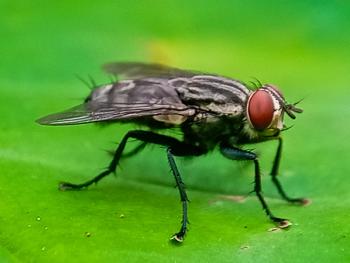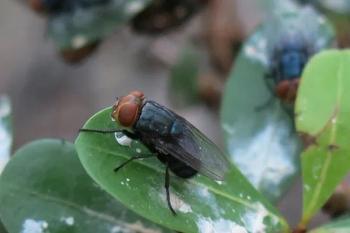
An overview of cestode infections in dogs and cats
Careful attention is needed both to prevent tapeworm infections and to ensure prompt, effective treatment when infections do occur.
Tapeworms are frequently recognized parasites in both dogs and cats in the United States. Dipylidium caninum and Taenia species are the most commonly reported, but other genera, including Echinococcus, Mesocestoides, Spirometra, and Diphyllobothrium, may be regionally important. These cestodes are widely considered nonpathogenic; however, tapeworms may occasionally cause disease in both pets and people. Careful attention is needed both to prevent tapeworm infections and to ensure prompt, effective treatment when infections do occur.
Susan E. Little, DVM, PhD, DEVPC
LIFE CYCLES
All cestodes have indirect life cycles, which require specific intermediate hosts (Table 1). Of the two major groups of cestodes found in dogs and cats (cyclophyllidean and pseudophyllidean), the cyclophyllidean tapeworms, or true tapeworms, are more common. Dogs and cats infected with adult cyclophyllidean tapeworms, such as Dipylidium caninum or Taenia, Mesocestoides, or Echinococcus species, shed egg-laden proglottids in their feces. When the appropriate intermediate host consumes these eggs, larval cysts develop. Dogs and cats are infected when they ingest the intermediate host that contains these larval cysts. These pets may then begin shedding proglottids of D. caninum, the common flea tapeworm, or Mesocestoides species as soon as two or three weeks after infection. For Taenia and Echinococcus species, the prepatent period may be as long as one or two months.1
Table 1: Intermediate Hosts of the Common Tapeworms in Dogs and Cats
In contrast, adult pseudophyllidean cestodes, such as Spirometra species or Diphyllobothrium latum, discharge individual operculated eggs through a median genital pore. These eggs hatch upon contact with water and develop in a copepod first intermediate host and a vertebrate second intermediate host before being ingested by a cat or dog definitive host and developing into an adult tapeworm. Dogs and cats may begin shedding pseudophyllidean tapeworm eggs as soon as 10 days after infection. Infections will only occur when dogs and cats ingest larvae in prey species or in undercooked animal tissue in an area where infection is cycling in nature.1
DISEASE IMPLICATIONS
Adult tapeworms reside in the small intestines of dogs and cats. Motile proglottids may be seen in the perianal region as they exit the animal, in the pet's environment (e.g. on bedding), or in the fecal material itself.
Although the common cestodes of dogs and cats, such as Dipylidium caninum and Taenia species, usually do not cause significant disease in pets,1 tapeworm infections are aesthetically unpleasant. The presence of proglottids on pets or in the home may cause distress to clients and can fracture the human-animal bond. In addition, infection of pets with these parasites poses a zoonotic health risk in the home. In contrast, the less commonly seen Mesocestoides species may occasionally induce peritoneal cestodiasis, and both Spirometra and Diphyllobothrium species have been associated with gastrointestinal disease characterized by vomiting, diarrhea, and weight loss in infected cats and dogs.2 For all of these reasons, control and treatment of tapeworms in pets is warranted.
PREVALENCE AND GEOGRAPHIC DISTRIBUTION
The reported prevalence of tapeworms in the Americas in published studies varies from 4% to 60% in dogs and 1.8% to 52.7% in cats.3-5 A number of factors influence the likelihood that a particular dog or cat will become infected with tapeworms, including the geographic region where the animal lives and the opportunity it has to ingest an infected intermediate host. Prevalence data generated by fecal flotation alone almost certainly underestimate the frequency of infection with Dipylidium caninum and Taenia species. Because proglottids, and thus eggs, are focally distributed in fecal material, a given fecal sample may not contain tapeworm proglottids or eggs even in the presence of an infection.3
Dipylidium caninum and Taenia species are found throughout North America. Mesocestoides species is less common than either D. caninum or Taenia species but does occasionally appear in foci throughout the United States. At present, Echinococcus species are thought to be largely limited to areas of Alaska and of the north-central, midwestern, and southwestern United States as well as areas of Canada.6
Spirometra and Diphyllobothrium species infections in dogs and cats are not as common as infection with cyclophyllidean cestodes, and studies reporting prevalence estimates have not been published. However, these tapeworms are known to be common in pets in some areas of the United States.
DIAGNOSIS
Diagnosing infection with Dipylidium caninum or Taenia species is achieved by identifying proglottids in the fecal material (Figure 1) or by recognizing the eggs on fecal flotation (Figures 2 & 3). When freshly shed, D. caninum proglottids have rounded edges and are often described as cucumber seed in shape, whereas those of Taenia species are more rectangular with sharp corners. Often, D. caninum or Taenia species infection is diagnosed based on a client's observation of proglottids, which can be motile when fresh or appear like grains of rice (or sesame seeds) when desiccated on or around the pet. When desiccated, the proglottids lose their characteristic shape. In these cases, the dried tapeworm segments can be rehydrated in saline solution, the tissue teased apart, and the material examined microscopically for the presence of characteristic eggs. Sterile cestode segments are often produced; however, the absence of eggs in a proglottid does not rule out the presence of a tapeworm infection. In addition, because proglottids are not uniformly distributed in the fecal material, fecal flotation alone is not a reliable means of diagnosing tapeworm infection in dogs and cats.
Figure 1. Dipylidium caninum proglottid and segments on a fecal mass.
Echinococcus species proglottids will not be grossly detected, and infection can only be identified by fecal flotation. Similarly, Spirometra and Diphyllobothrium species eggs can only be found on fecal examination (Figure 4), although occasionally, long segments of adult Spirometra or Diphyllobothrium species may be found in vomit or feces. In these cases, the adult tapeworms can be identified grossly by the presence of a distinct medial genital pore.7
Figure 2. A packet of Dipylidium caninum eggs. Individual eggs of D. caninum have refractile hooks inside the egg, and each measure about 40 to 50 μm in diameter but are usually shed in packets containing 25 to 40 eggs. The size of the entire packet varies somewhat but may be 120 to 200 μm long.
STRATEGIES TO CONTROL TAPEWORMS IN PETS
Tapeworms in dogs and cats can be treated with praziquantel, epsiprantel, or fenbendazole. Praziquantel and epsiprantel are considered the treatments of choice because they are highly effective against Dipylidium caninum—the most common tapeworm in dogs and cats—as well as Taenia and Echinococcus species, although only praziquantel is labeled as effective against Echinococcus species; fenbendazole is not effective against D. caninum and is not labeled against Echinococcus species.8 Praziquantel also has been used successfully to treat pseudophyllidean tapeworms, but this application requires a higher-than-labeled dose and extended duration of treatment (25 mg/kg orally for two consecutive days2 ).
Figure 3. A Taenia species egg. The eggs are shed individually and have thick striated walls and clearly visible refractile hooks. They measure 30 to 40 μm in diameter.
However, to be effective, treatment of tapeworm infections in dogs and cats must be combined with appropriate management modifications. For example, stringent adherence to controlling fleas and lice is required to prevent D. caninum infections. Preventing predation and scavenging activity by keeping cats indoors and dogs confined to a leash or in a fenced yard will limit the opportunity for pets to acquire infection with Taenia, Echinococcus, or Spirometra species or Diphyllobothrium latum through ingestion of intermediate hosts. In the absence of these changes, reinfection is likely to occur.1 Because both flea infestations and scavenging behaviors are difficult to prevent entirely, routine monthly deworming of some dogs and cats with a broadly cestocidal compound such as praziquantel may be indicated, particularly for dogs and cats in areas where Echinococcus species is endemic.
Figure 4. A Spirometra species egg. Spirometra species shed operculate, hen-egg-shaped ova that are about 65 μm long by 35 μm wide.
ZOONOTIC POTENTIAL
In North America, Echinococcus species infections in people are rare6 ; isolated reports of zoonotic infection with larval Taenia species of dogs and cats also exist.9 Although the overall risk of human infection with these parasites in North America is extremely low, dogs and cats infected with these tapeworms do create a potential zoonotic risk. Taenia and Echinococcus species eggs shed in the feces of an infected dog or cat are immediately infectious to the intermediate host.1 People who consume these eggs may develop cestode cysts requiring drainage, surgical removal, or extended chemotherapy. In the case of Echinococcus multilocularis, surgery is unlikely to be successful, and long-term anthelmintic therapy may be required.6
Dipylidium caninum infections in children who have ingested infected fleas are occasionally reported.10 The disease induced in children is generally mild, confined to the intestinal tract, and readily treated but can still be distressing to the families. People are a normal definitive host of Diphyllobothrium latum and may become infected with this tapeworm after ingesting larvae in raw fish.1 Spirometra species are also zoonotic; people who inadvertently ingest Spirometra species-infected copepods in water or spargana in the tissue of an infected second intermediate host can develop the larval form. In North America, people with Spirometra species infections usually present with flocculent subcutaneous masses; larvae have also been reported to develop in ocular tissue and in the central nervous system.2
Editors' note: Dr. Little has received research funding from Bayer Animal Health.
Susan E. Little, DVM, PhD, DEVPC
Department of Veterinary Pathobiology
Center for Veterinary Health Sciences
Oklahoma State University
Stillwater, OK 74078
REFERENCES
1. Bowman DB. Helminths. In: Georgis' parasitology for veterinarians. 8th ed. Philadelphia, Pa: WB Saunders Co, 2003;115-243.
2. Little SE, Ambrose DL. Spirometra infection in cats and dogs. Compend Contin Educ Pract Vet 2000;22:299-305.
3. Blagburn BL. Prevalence of canine and feline parasites in the United States. Compend Contin Educ Pract Vet 2001;suppl 23:5-10.
4. Labarthe N, Serrao ML, Ferreira AM, et al. A survey of gastrointestinal helminths in cats of the metropolitan region of Rio de Janeiro, Brazil. Vet Parasitol 2004;123:133-139.
5. Eguia-Aguilar P, Cruz-Reyes A, Martinez-Maya JJ. Ecological analysis and description of the intestinal helminths present in dogs in Mexico City. Vet Parasitol 2005;127:139-146.
6. Kazacos KR. Cystic and alveolar hydatid disease caused by Echinococcus species in the contiguous United States. Compend Contin Educ Pract Vet 2003;suppl 25:16-20.
7. Zajac AM, Conboy G. Fecal examination for the diagnosis of parasitism. In: Veterinary clinical parasitology. 7th ed. Ames, Iowa: Blackwell Publishing, 2006;3-147.
8. Plumb DC. Veterinary drug handbook. 5th ed. Ames, Iowa: Blackwell Publishing, 2005.
9. Heldwein K, Biedermann HG, Hamperl WD, et al. Subcutaneous Taenia crassiceps infection in a patient with non-Hodgkin's lymphoma. Am J Trop Med Hyg 2006;75:108-111.
10. Molina CP, Ogburn J, Adegboyega P. Infection by Dipylidium caninum in an infant. Arch Pathol Lab Med 2003;127:e157-159.
Newsletter
From exam room tips to practice management insights, get trusted veterinary news delivered straight to your inbox—subscribe to dvm360.





